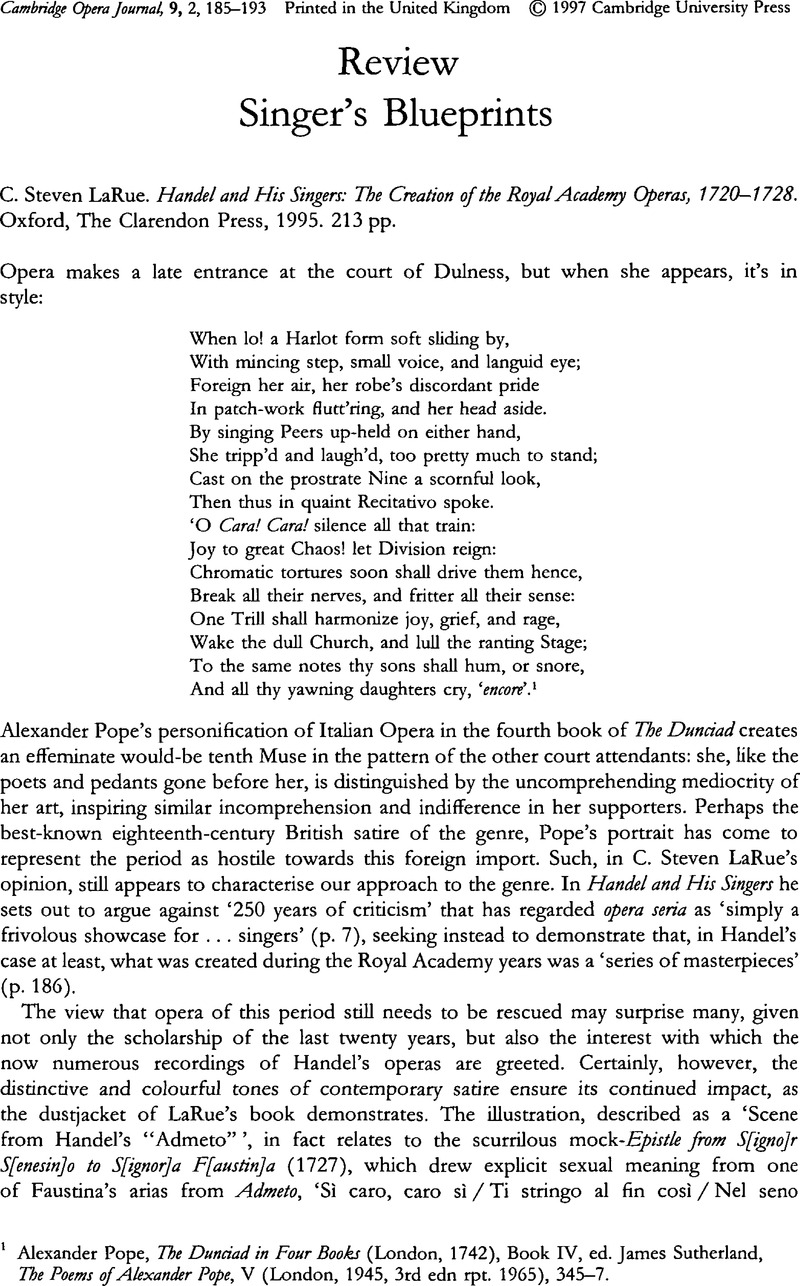Published online by Cambridge University Press: 27 August 2008

1 Pope, Alexander, The Dunciad in Four Books (London, 1742), Book IV, ed. Sutherland, James, The Poems of Alexander Pope, V (London, 1945, 3rd edn rpt. 1965), 345–7Google Scholar
2 The translation in the original libretto, Admeto, Re di Tessaglia (London, 1727), reads: Yes, my life, my loveliest Dear, Thus I grasp and clasp thee here Close to my panting Heart.Google ScholarHarris, Ellen T., ed., The Librettos of Handel's Operas, 13 vols. (New York, 1989), V, 155.Google Scholar
3 Senesino, for instance, as LaRue notes (p. 115). One of Senesino's ‘vocal strengths’, the motto opening (p. 111), is also typical of Durastanti (p. 140).Google Scholar
4 Milhous's, Judith review of Handel and His Singers in Notes, 53 (1996), 458.Google Scholar
5 For example: ‘Ferite, uccidete’ should not occur in the Lalli-Gasparini column of Table 4.1 (p. 85); ‘Se vive in te’ in Table 4.1 becomes ‘Se teco vive’ in Table 5.1 (p. 109) with no explanation; in discussion of Cuzzoni's and Faustina's roles in Alessandro (pp. 145ff.), we only learn who played which character in Table 7.4 (p. 160); LaRue's own article (cited p. 133 n. 10) is not included in the bibliography. LaRue does not adhere to his policy on footnoting textual sources (p. 14); Mattheson's quote on pastoral, given in a footnote (p. 170 n. 22), is repeated in the text (p. 178); material on page 91 is repeated verbatim on page 108; the index does not include secondary sources, and a sampling of other references reveals lacunae.Google Scholar
6 Three figures, three tables and nine musical examples take up approximately 28 of the 63 pages in this chapter.Google Scholar
7 Dean, Winton and Knapp, John Merrill, Handel's Operas, 1704–1726 (Oxford, 1987, rev. edn 1995).Google Scholar
8 Strohm, Reinhard, Essays on Handel and Italian Opera (Cambridge, 1985), 102.Google Scholar
9 Pope's note, The Dunciad, ed. Sutherland, , 345.Google Scholar
10 See, for example, Dean and Knapp, Handel's Operas, 8.Google Scholar
11 Pope, Alexander, Gay, John, Swift, Jonathan, The Memoirs of Scriblerus (London, 1714);Google Scholarcited in Fox, Christopher, Locke and the Scriblerians: Identity and Consciousness in Early Eighteenth-Century Britain (Berkeley and Los Angeles, 1988), 1–2.Google Scholar
12 Fox, Locke and the Scriblerians, 32.Google Scholar
13 Ober, William B., ‘Eighteenth-Century Spleen’, Psychology and Literature in the Eighteenth Century, ed. Fox, Christopher (New York, 1987), 225–58.Google Scholar
14 Smeed, J. W., The Theophrastan ‘Character’: The History of a Literary Genre (Oxford, 1985), 64–81.Google Scholar
15 Korshin, Paul J., Typologies in England, 1650–1820 (Princeton, 1982);Google ScholarCarretta, Vincent, The Snarling Muse: Verbal and Visual Political Satire from Pope to Churchill (Philadelphia, 1983).Google Scholar
16 Lindgren, Lowell, review of Handel and His Singers, Opera Quarterly, 13/1 (1996), 76.Google ScholarRobinson secretly married the Earl of Peterborough; Burrows, Donald, Handel (Oxford, 1995), 111.Google Scholar
17 Holland, Peter, The Ornament of Action (Cambridge, 1979);Google ScholarPowell, Jocelyn, Restoration Theatre Production (London, 1984);Google ScholarDonohue, Joseph W. Jr, Dramatic Character in the English Romantic Age (Princeton, 1970), 3–92.Google Scholar
18 Existing studies of the impact of contemporary performing conventions on opera tend to deal more with the physical than the psychological. See, for example, Solomon, Nicholas, ‘Signs of the Times: A Look at Late 18th-Century Gesturing’, Early Music, 17 (1989), 551–62;CrossRefGoogle ScholarHeartz, Daniel, ‘From Garrick to Gluck: The Reform of Theatre and Opera in the Mid-Eighteenth Century’, Proceedings of the Royal Musical Association, 94 (1967–1968), 111–27.CrossRefGoogle Scholar
19 Burrows, , Handel, 110.Google Scholar
20 Feldman, Martha, ‘Magic Mirrors and the Seria Stage: Thoughts toward a Ritual View’, fournal of the American Musicological Society, 48 (1995), 423–84, especially 460–8.CrossRefGoogle Scholar